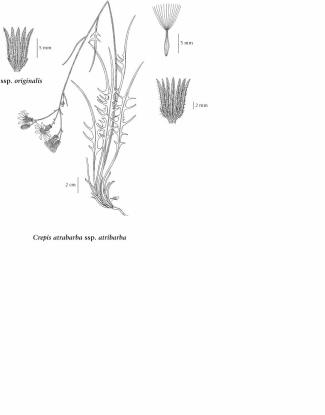Crepis atribarba A. Heller subsp. atribarba
slender hawksbeard
Asteraceae (Aster family)
Introduction to Vascular Plants
slender hawksbeard
Asteraceae (Aster family)
Introduction to Vascular Plants
Map
Distribution of Crepis atribarba subsp. atribarba
Click here to view the full interactive map and legend
Species Information
General:
Perennial herb from a taproot and woody base; stems erect, 1-2, grey-woolly or sometimes eventually becoming glabrous, 15-70 cm tall.
Leaves:
Basal leaves linear to lanceolate, long-stalked, pinnately or bipinnately divided into linear or lanceolate segments or rarely entire, greyish-woolly or more often nearly glabrous, 10-35 cm long; stem leaves similar to the basal ones, becoming linear and entire upwards.
Flowers:
Heads with strap-shaped flowers, 3-40 in a flat- to round-topped inflorescence; involucres 8-15 mm tall, cylindric; involucral bracts greyish-woolly to nearly glabrous or rarely glabrous, with or without black, glandless bristles on the inner and sometimes the outer bracts, the outer ones 5-10, deltoid, abruptly sharp-pointed, the longest less than 1/2 as long as the 8-10 inner ones, these lanceolate, abruptly sharp-pointed or obtuse; ray flowers yellow, 10-18 mm long.
Fruits:
Achenes usually greenish or rarely brownish, 3-10 mm long, slender, weakly to strongly ribbed, mostly tapering to a slender tip at the apex; pappus white, of hairlike bristles.
Notes:
Two subspecies occur in BC:
1. Plants relatively small, 15-35 cm tall; heads 3-18; involucral bracts with some glandless bristles...................... ssp. atribarba
1. Plants taller, 30-70 cm tall; heads 10-40; involucral bracts nearly or completely devoid of bristles...................... ssp. originalis Babc. & Stebb.
Illustration

If more than one illustration is available for a species (e.g., separate illustrations were provided for two subspecies) then links to the separate images will be provided below. Note that individual subspecies or varietal illustrations are not always available.
Illustration Source: The Illustrated Flora of British Columbia
Habitat and Range
Dry sandy or gravelly grasslands, shrublands and open forests in the steppe and lower montane zones; common (ssp. originalis) or rare (ssp. atribarba) in S BC east of the Coast-Cascade Mountains; E to AB and S to NV, UT and CA.Status Information
Synonyms
Synonyms and Alternate Names:
Crepis atribarba subsp. cytotaxonomicorum (B. Boivin) W.A. Weber
Crepis atribarba subsp. typicus Babc. & Stebbins
Crepis atribarba var. cytotaxonomicorum B. Boivin
Psilochenia atribarba (A. Heller) W.A. Weber